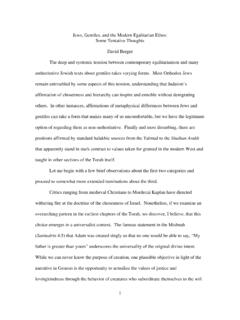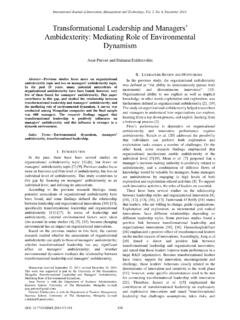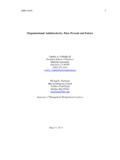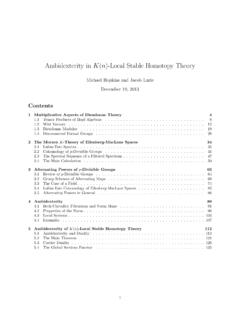Transcription of Dynamic ambidexterity: How innovators manage exploration ...
1 Dynamic ambidexterity : How innovatorsmanage exploration and exploitationYan ChenSchool of Business, Stevens Institute of Technology, Castle Point on Hudson, Hoboken, NJ 07030, The innovator s dilemma: AnotherlookDisruptive change often causes firms to stumble andfall (Christensen, 1997). Such was the case of DisneyAnimation Studios. In the era of hand-drawn anima-tion, Disney created such culture-defining films asSnow White and the Seven Dwarfs, Beauty and theBeast, and The Lion King. Disney excelled at hand-drawn animation, but it struggled to adapt to com-puter animation. It was Pixar, not Disney, thatreleased the world s first computer-animated fea-ture film in 1995, at which point computer anima-tion started to disrupt hand-drawn this shift within the animation industry,Disney only managed to release its first partiallycomputer-animated feature film in 2000 and its firstfully computer-animated feature film in 2005.
2 Infact, after the release of The Lion King in 1994,Disney s animation empire reverse its decline, Disney had to acquire Pixarin 2006 and let Pixar s leadership team take over themanagement of Disney Animation. Since then, thenew leadership team has implemented a new set ofmanagerial practices to revive Disney Animation,Business Horizons (2017) 60, 385 394 Available online at andexploitation;Organizationalambidexter ity;Strategic management;Innovation culture;Market orientationAbstract Firms must excel at both exploration and exploitation to ensure long-term survival and prosperity. However, firms often have difficulties in doing sobecause they have to accommodate the contradictory logics of exploration andexploitation. This article examines the logics of exploration and exploitation,evaluates the difficulties of accommodating both logics, and identifies dynamicambidexterity as a new way to overcome these difficulties.
3 To achieve dynamicambidexterity, firms need to support structural ambidexterity at the corporate level,contextual ambidexterity at the business-unit level, and sequential ambidexterity atthe project level. I believe that the notion of Dynamic ambidexterity and itsmanagerial practices can help firms manage exploration and exploitation and ensurelong-term survival and prosperity.# 2017 Kelley School of Business, Indiana University. Published by Elsevier Inc. Allrights address: 2017 Kelley School of Business, Indiana University. Published by Elsevier Inc. All rights its resurgence with a number of newcomputer-animated films, including Frozen, BigHero 6, and Zootopia. Disney s story shows thatfirms, even the most successful ones, can fail torespond to disruptive change. More importantly, italso suggests that in the face of disruption, firms cantake measures to reverse their decline, developnew capabilities, and seize new opportunities(Catmull, 2014; Stewart, 2005).
4 To meet the challenge of disruptive change, firmsneed both to explore and exploit (March, 1991). Theyexploit existing information and capabilities to en-sure short-term success and explore new informationand possibilities to achieve long-term , even well-managed firms often succeedat exploitation but fail at exploration (Christensen,1997; Cooper & Schendel, 1976; March, 1991).They excel at exploiting existing technologies andmarkets while often missing out on new technologiesand markets. innovators often face a dilemma thedilemma of how to avoid missing out on new oppor-tunities while existing ones need this article, I take a new look at the innovator sdilemma, the root cause of which is not thatfirms disregard new opportunities but that theymismanage exploration . exploration and exploita-tion follow different logics and call for differentmanagerial practices. But the logic of exploitationtoo often overshadows the logic of exploration infirms, resulting in the mismanagement of explora-tion.
5 One way to resolve the innovator s dilemmais through organizational ambidexterity : buildingorganizational capabilities to accommodate con-tradictory logics. Prior research has proposed manyways to achieve organizational ambidexterity , andeach has its merits and limits. In this article, Ipropose a new form of ambidexterity dynamicambidexterity which builds on existing formsand mitigates their limits. Dynamic ambidexterityachieves structural ambidexterity at the corporatelevel by dedicating some business units to explo-ration and others to exploitation. It achieves con-textual ambidexterity at the business-unit level bycreating an organizational context in which em-ployees within each business unit are encouragedto explore and exploit. It achieves sequentialambidexterity at the project level by matchingprojects at different stages to business unitswith different characteristics. I believe that dy-namic ambidexterity represents a comprehensivesolution to the management of exploration this article, I will investigate the nature andcharacteristics of Dynamic ambidexterity .
6 In thenext section, I will start with a brief discussionof the contradictory logics of exploration andexploitation, followed by an overview of the chal-lenges of achieving organizational The logics of exploration andexploitationA logic is the means by which managers conceptu-alize a business and make critical decisions aboutthe business (Prahalad & Bettis, 1986). The logicsof exploration and exploitation are contradictoryin the sense that they represent different concep-tions of businesses and call for divergent manage -rial practices (Besharov & Smith, 2014). In thissection, we will examine the nature of these The logic of exploitationExploitation focuses on utilizing what firms havealready known (March, 1991). An exploitative ori-entation relies on the assumption that the firm hascomplete information about external opportunitiesand internal capabilities. Exploitative firms expectto work within well-established problem-solutionframeworks, under which problems and solutionscan be clearly defined.
7 Organizational attention isfocused on existing businesses or existing waysof doing businesses and on employing availableinformation and capabilities to achieve short-termorganizational goals and market positions. Exploi-tation involves low levels of uncertainty and hashigh rates of well-managed firms are good at exploitation(March, 1991). They strive for short-term successes,which require them to deliver reliable revenues andprofits (Govindarajan & Trimble, 2010). As such,ongoing operations are optimized to improve orga-nizational performance, creating further pressuresfor future performance. The pressure to deliverconsistent and reliable results focuses organization-al attention on improving reliability, efficiency, andcontrol. In this way, exploitative firms have de-signed and shaped their managerial practices tofit the logic of The logic of explorationUnlike exploitation, exploration focuses on dis-covering what is yet to be known (March, 1991).
8 Exploratory business investigates new businesses ornew ways of doing businesses. An exploratory ori-entation suggests that a firm may not have completeinformation about all possible opportunities, so itneeds to sense and seize new opportunities (Teece,2007). exploration centers on the belief that firms386 Y. Chenmay have not yet reached their maximum capabili-ties, so they need to stretch their existing capabili-ties (Wang & Chen, 2015), transform existingcapabilities (Teece, 2007), or develop new capabil-ities (Capron & Mitchell, 2009). Unlike exploitation, exploration consumes resources in the short runand its returns are uncertain, distant, and delayed(Arend & Chen, 2012). It creates new possibilities,but it often produces early failures and results intemporary performance declines. exploration in-volves high levels of uncertainty and has low ratesof many well-managed firms may be success-ful at exploitation, many of these are also poorat exploration (Christensen, 1997; Christensen &Raynor, 2003).
9 They are well-managed, so theyfocus their attention on what is creating themost value and focus less attention on what isnot creating value. Because exploration rarelycreates immediate value, there is good reasonto focus less attention on it. Moreover, well-managed firms often want breakthroughs but donot tolerate early failures. However, the toler-ance for early failures is exactly what is neededfor exploration . exploration usually starts out asearly failures and disappointments, and not everyearly failure will lead to a breakthrough. Early on,firms often cannot distinguish productive earlyfailures from unproductive ones. In trying to avoidfailures, they may also eliminate productivesteps and give up on opportunities to producebreakthroughs. To excel at exploration , firmsneed to understand the logic of exploration andmanage it Toward Dynamic ambidexterityThe best way to accommodate the contradictorylogics of exploration and exploitation is throughorganizational ambidexterity , which O Reilly andTushman (2013, p.)
10 324) describe as:The ability of an organization to both exploreand exploit to compete in mature technolo-gies and markets where efficiency, control, andincremental improvement are prized and toalso compete in new technologies and marketswhere flexibility, autonomy, and experimenta-tion are are many different forms of organizationalambidexterity. In this section, I will evaluatethese different forms and identify their res-pective limits. I will then propose a new formof ambidexterity Dynamic ambidexterity whichcombines insights and practices from all threeforms of ambidexterity . I believe that dynamicambidexterity represents a comprehensive solu-tion to the innovator s Contextual ambidexterity and itslimitsContextual ambidexterity may be used to pursueexploration and exploitation by creating an organi-zational context within which employees can freelychoose to explore or exploit (Birkinshaw & Gibson,2004; Gibson & Birkinshaw, 2004).
















